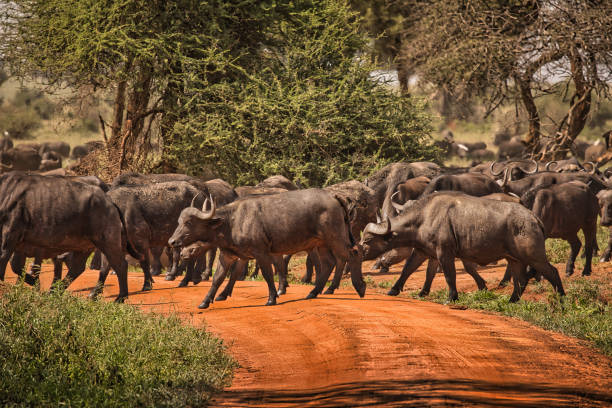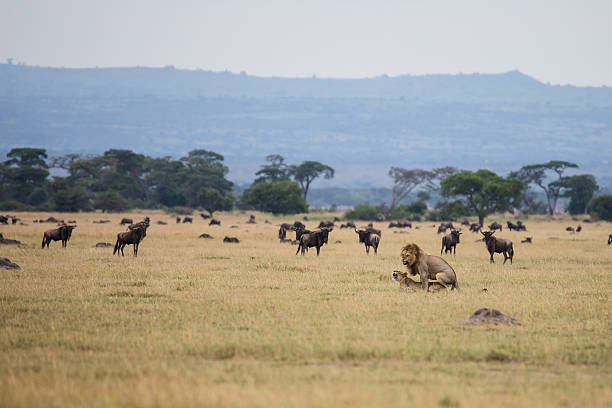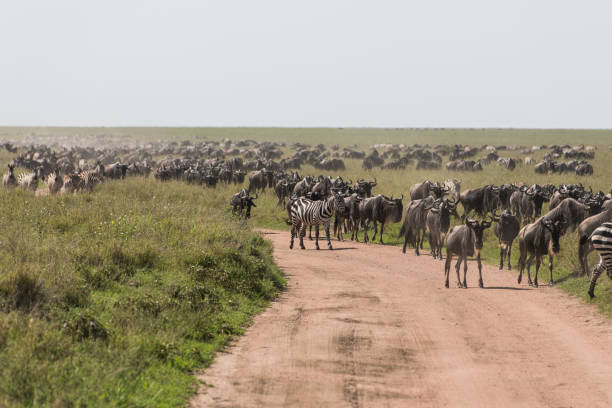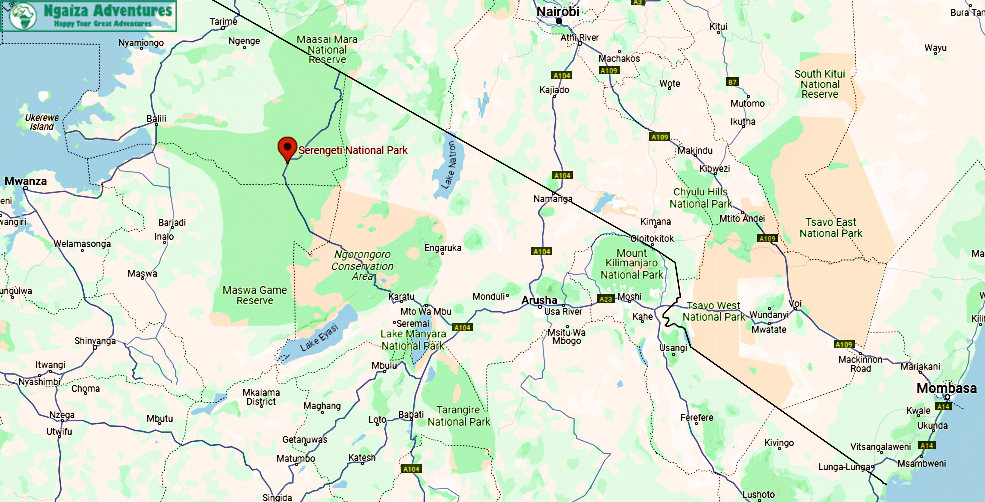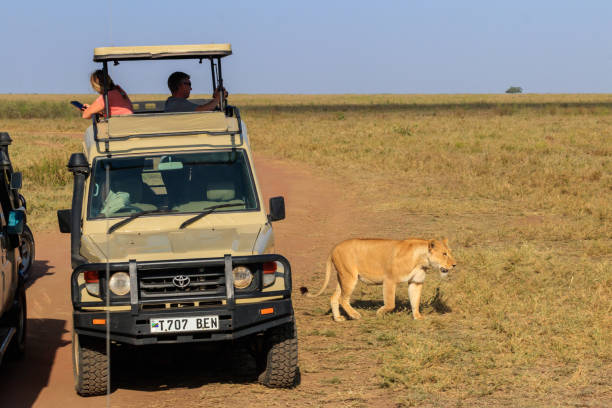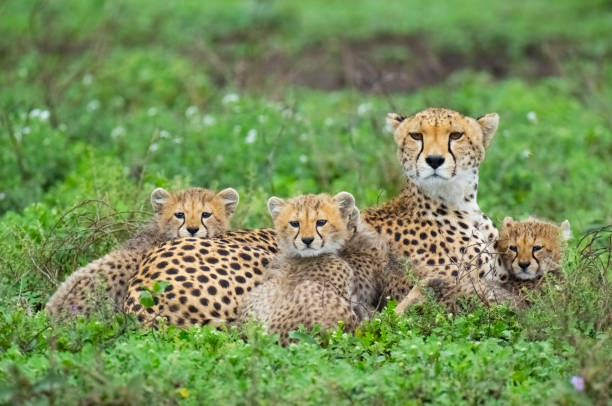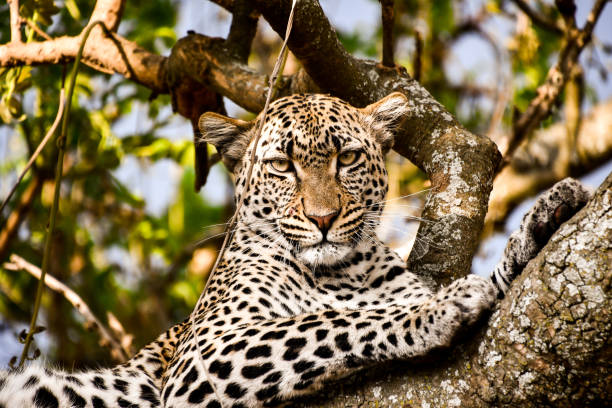History Of Serengeti National Park
History On Serengeti Wildlife Safari - Best of Tanzania's Safari Destination
More About Serengeti National Park
In the late 1800s and early 1900s, explorers and missionaries described the Serengeti plains and the massive numbers of animals found there. Only minor details are all that were reported before explorations in the late 1920s and early 1930s supply the first references to the great wildebeest migrations, and the first photographs of the region.
An area of 2,286 square kilometers was established in 1930 as a game reserve in what is now southern and eastern Serengeti. They allowed sport hunting activities until 1937, after which it stopped all hunting activities. In 1940 Protected Area Status was conferred to the area and the National Park itself was established in 1951, then covering southern Serengeti and the Ngorongoro highlands. They based the park headquarters on the rim of Ngorongoro crater.
So, the original Serengeti National Park, as it was gazetted in 1951, also included what now is the Ngorongoro Conservation Area (NCA). In 1959, the Ngorongoro Conservation Area was split off from the Serengeti National Park and they extended the boundaries of the park to the Kenya border. The key reason for splitting off the Ngorongoro area was that local Maasai residents realized that they were threatened with eviction and consequently not allow to graze their cattle within the national park boundaries. To counter this from happening, protests were staged. A compromise was reached wherein the Ngorongoro Crater Area was split off from the national park: the Maasai may live and graze their cattle in the Ngorongoro Crater area but not within Serengeti National Park boundaries.
In 1961 the Masai Mara National Reserve in Kenya was established and in 1965 the Lamai Wedge between the Mara River and Kenya border was added to Serengeti National Park, thus creating a permanent corridor allowing the wildebeests to migrate from the Serengeti plains in the south to the Loita Plains in the north. The Maswa Game Reserve was established in 1962 and a small area north of The Grumeti River in the western corridor was added in 1967.
The Serengeti National Park was among the first places to be proposed as a World Heritage Site by UNESCO at 1972 Stockholm conference. It was formally established in 1981.
Things to Do In Serengeti Natonal Park
Activities on Serengeti Wildlife Safari
Serengeti Migration
Witness the Great Migration in Serengeti National Park
The annual migration of over a million wildebeest stands out as the Serengeti's main draw. Witnessing this awe-inspiring spectacle is truly remarkable as herds cascade across the plains, navigating rivers in pursuit of water and fresh grass. The sprawling mega herds, extending up to 40 km, cover a distance of about 1000 kilometers. This arduous journey presents a constant challenge for wildebeest, zebras, and gazelles, necessitating strategies to outsmart their predators. Particularly perilous is the Mara and Grumeti River crossing, where formidable crocodiles and swift currents lie in wait. Recognized among the Seven Natural Wonders of the World, the Great Migration captivates many visitors, marking one of the world's grandest wildlife spectacles. The migration occurs in a circular route between the Serengeti and Masai Mara (Kenya) year-round, with timing contingent on annual rainfall patterns. Our experienced Tanzania Specialist guides enable fairly accurate predictions, allowing you to plan your visit and witness this extraordinary event at different times of the year. Explore our page for detailed insights into the wildebeest migration.
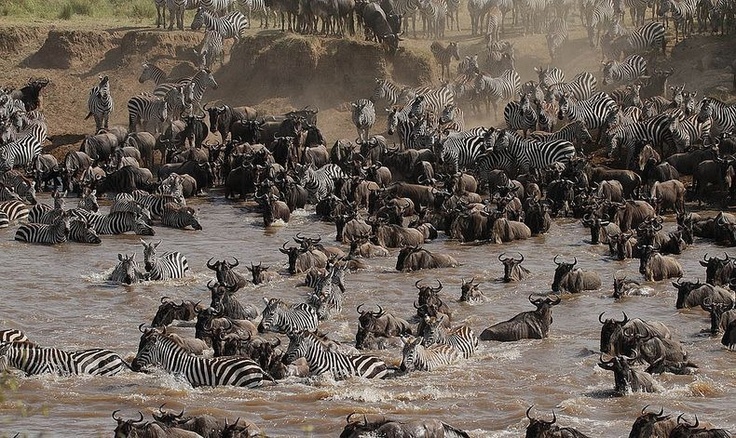
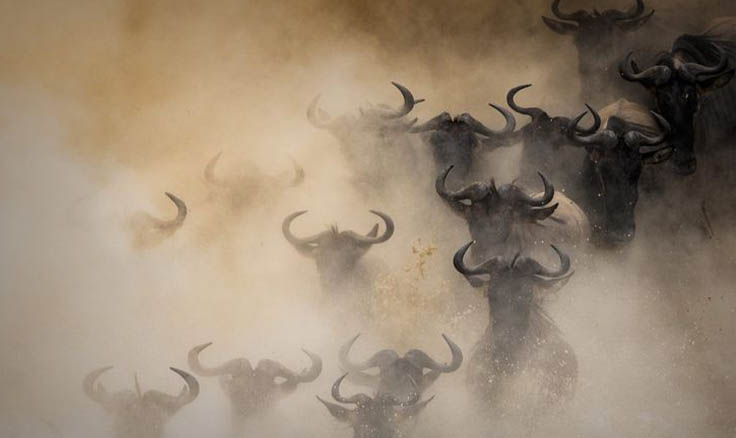
Getting closer presents a multitude of impressive episodes of this saga - the Migration attracts hundreds of feline predators (lions, leopards and cheetahs), lurking around and looking for the weakest and the oldest. Stirring scenes occur when the wildebeests, zebras and gazelles cross the rivers - insidious, cold-blooded and watchful crocodiles are staging bloody ambushes. Breathtaking hunting dramas are played out.
The Great Migration season in Northern Tanzania is from July till September. The herds are crossing the main water artery of the National Parks, River Mara, a hideout of the bloodthirsty crocodiles, in June.
When do Wildebeest Migrates?
Wandering through Tanzania's diverse landscapes, the migration unfolds in distinct chapters:
- Central & south-East Serengeti (Nov & Dec): Witness the migration's initiation in the heart of the Serengeti.
- South & central Serengeti (Jan to Mar): Experience heightened drama as survival and birth take center stage.
- West Serengeti (Apr to Jun): Traverse the west, witnessing nature's resilience and constant renewal.
- Crossing to Maasai Mara (Jul to Oct): The climax unfolds as herds navigate the treacherous river, defining the peak of the Great Migration.
This is not just a migration; it's a rare opportunity to witness the pulse of life in one of the world's most iconic ecosystems. Elevate your experience with a Hot Air Balloon safari, soaring above the vast Serengeti plains. This extraordinary journey promises a lifetime of memories, etching the grandeur of the Serengeti's Great Migration into your travel narrative.
The journey for the key players in the Great Migration, the roughly two million wildebeest, starts in the south of the Serengeti, with the birth of half a million calves between January and March. A favourite season for many of the seasoned Serengeti guides: the air during these months is full of new life and action. Read all about Africa's biggest wildlife event on this page.
Why do wildebeest migrate?
Have you ever wondered why wildebeests, those iconic African animals, travel such long distances? Let's unravel the mystery of their migration in the Serengeti, one of nature's most incredible stories.
Picture this: A vast expanse of grassy plains transforms as the rainy season arrives. It's during this time that wildebeests, known for their keen sense of timing, begin an extraordinary 800-kilometer journey. Why? Because these plains become a perfect spot for their babies to be born – a safer place where predators are easier to spot.
But as the land dries up, the wildebeests must move. They head west in search of better food in the western corridor. It's not the easiest journey – they face rivers, predators, and even crocodiles waiting for a meal. The Serengeti's lions, the kings of the jungle, are there too, making life challenging.
The journey continues northward into Kenya, facing more challenges like river crossings. The herds, including gazelles and zebras, devour the lush greenery. However, danger lurks as crocodiles lie in wait. Witnessing a group of lions teaming up to catch a wildebeest is a sight to remember!
With the return of rain in late October, the wildebeests make their way back home to the Serengeti. By December, they pass through Seronera, a small settlement in central Serengeti, marking the completion of their journey. This entire cycle is a symbol of life's rhythm, showcasing nature's wonders in the great Wildebeest Migration.
Birdwatching in the Serengeti
The Serengeti is renowned for its incredible wildlife, and birdwatching in this iconic region can be a rewarding experience. While the park is famous for its large mammals and the Great Migration, it also offers diverse habitats, providing a home to numerous bird species.
Notable Birds in the Serengeti
- Secretary Bird (Sagittarius serpentarius): A distinctive bird of prey often seen hunting in the grasslands.
- Superb Starling (Lamprotornis superbus): Known for its striking iridescent plumage, a common and colorful species.
- Yellow-billed Hornbill (Tockus flavirostris): Recognizable by its large, downward-curved yellow bill, often perched on tree branches.
- Lilac-breasted Roller (Coracias caudatus): A beautifully colored bird known for vibrant plumage and impressive aerial displays.
- Grey-crowned Crane (Balearica regulorum): An elegant bird often seen in wetland areas with a distinctive golden crown.
- African Fish Eagle (Haliaeetus vocifer): A majestic bird of prey found near water sources, known for its distinctive call.
- Marabou Stork (Leptoptilos crumenifer): A common sight with significant ecological importance despite its appearance.
- African Grey Hornbill (Lophoceros nasutus): Recognizable by its large, curved bill and distinctive call, often found in wooded areas.
- Hildebrandt's Starling (Lamprotornis hildebrandti): Another beautiful starling species characterized by glossy blue and black plumage.
- White-backed Vulture (Gyps africanus): Scavengers often seen circling in the sky, playing a crucial role in the ecosystem.
For the best experience, bring binoculars and a field guide. Guided safaris with knowledgeable local guides can enhance your birdwatching adventure and provide insights into the diverse avian species of the Serengeti.
Hot Air Balloon Safari in the Serengeti
Experience the Serengeti like never before with a hot air balloon safari. This unique adventure offers a breathtaking aerial view of the iconic African savannah, allowing you to witness the vast landscapes and incredible wildlife from the tranquility of a balloon basket.
As the balloon ascends with the sunrise, enjoy panoramic views of the Serengeti plains, the Great Migration, and diverse wildlife below. The silence of the balloon ride enhances the magic of the experience, providing both a serene and dynamic perspective of the ecosystem.
Conclude your adventure with a champagne breakfast in the heart of the Serengeti, making this a memorable and romantic addition to your safari journey.
Note: Ensure to book with a reputable and licensed operator for a safe and enjoyable hot air balloon safari.
Areas In Serengeti National Park
Areas On Serengeti Wildlife Safari And accommodations
Exploring Seronera & Southcentral Serengeti Plains
Imagine being in Seronera, a special place in Serengeti National Park with the oldest tourist lodge. It's more than just a spot; it's a hub of activity with a visitor center, a small museum, a coffee shop, and even a picnic area. A bunch of campsites and lodges nearby make it a perfect base for your Serengeti adventures. And don't forget the balloon safaris – they're a real treat, making Seronera truly the heart of the Serengeti.
When you stay in or visit Seronera, you get a bit of everything. It's right in the middle of Serengeti National Park, so you compromise a bit on avoiding crowds, but what you get in return is incredible. During the December-April rain season, southeast of Seronera becomes a wildlife hotspot. Imagine herds of wildebeest everywhere! Plus, it's called the predator capital of the world – you're almost guaranteed to see leopards, cheetahs, and lions. The best time? March to May, when the wildebeest take center stage. Yes, it gets crowded, but the landscapes are diverse, and there's water all year round. Lots of wildlife, easy access, and facilities – but, yes, be ready for lots of other visitors. Sometimes it feels like everyone's here, especially when there's a lion sighting. But you can still enjoy Seronera – try avoiding the crowds or pick a more remote place to stay.
accommodations
- Namiri Plains
- Four Seasons
- Dunia Camp
- Siringit Serengeti Camp
- &Beyond Serengeti Under Canvas (Apr/May & Nov/Dec)
Southeastern Plains & Ndutu: A Wildlife Haven
Imagine the southeastern Serengeti – a wildlife paradise throughout the year, but it reaches its peak between December and April. During this time, the plains come alive with giant herds of wildebeest and zebra, drawn by the refreshing seasonal rains. The hotspot for wildlife action? It's around Lake Ndutu, right in the heart of the wildebeest gathering. This is the spot where female wildebeest give birth to countless calves, a highlight of the Great Migration. However, it's not just a happy scene – it's also a stage for predators, creating a dramatic cycle of new life and, unfortunately, death.
The vachellia woodlands surrounding the lakes add another layer of magic, providing shelter to a variety of birds that you won't find anywhere else in the Serengeti. Keep your eyes peeled, and you might catch a glimpse of the fantastically colored Fischer's lovebird. But here's the thing – with all this action happening, the area attracts not only predators but also a lot of visitors, leading to high vehicle traffic. Also, be ready for some rain between December and March. Despite the crowds and occasional rain, the southeastern Serengeti and Ndutu offer a wildlife spectacle like no other. It's a trade-off well worth experiencing.
accommodations
- Olakira Migration Camp
Olakira (Dec-Mar)
- Mwiba Lodge
- Sanctuary Kusini Safari Camp
- Serengeti Under Canvas (Dec-Apr)
Western Corridor: A Nature's Canvas
Picture the Western Corridor of Serengeti, a region painted with beauty, adorned by the Grumeti and Mbalageti rivers. These rivers nurture expansive riverine forests and embrace minor mountain ranges before gracefully meeting Lake Victoria. It's a place where nature unfolds in diverse forms, showcasing a spectrum of resident wildlife throughout the entire year.
The prime time for visitors is from May to July, coinciding with the magnificent Great Migration passing through the Western Corridor on its journey northward. While the Grumeti River crossing might be less renowned than its northern counterpart, the Mara River crossing, it offers equally thrilling sightings. What makes it even more special? The chance to witness the spectacle with fewer fellow visitors, allowing you to immerse yourself in the raw beauty of the crossing. The Grumeti River stands as the first formidable obstacle for the migrating herds.
The landscape of the Western Corridor differs from its northern counterparts. It's flatter, richer in moisture, and more densely vegetated than the southern plains. Picture park-like woodlands, patches of open grassland, and clusters of the whistling thorn (Vachellia drepanolobium) standing tall in this unique stretch of land. The Western Corridor isn't just a destination; it's a canvas where nature's artistry comes to life.
accommodations
- Nomad Safari Camp (Jun-Jul)
- Mbali Mbali Soroi Serengeti Lodge
- Serengeti Under Canvas (Jun-Jul)
Grumeti Game Reserve: Serengeti's Hidden Gem
Enter the enchanting realm of Grumeti Game Reserve, an integral part of the greater Serengeti ecosystem, adjacent to Serengeti National Park. Conceived in 1994 to safeguard the annual wildebeest migration route, the stewardship of the 350,000 acres that make up Grumeti was entrusted to the Grumeti Community and Wildlife Conservation Fund, now known as the Grumeti Fund, in 2002. This is a commitment to conservation, ensuring the prosperity of this Serengeti haven.
Nestled in the remote western reaches of the Serengeti, Grumeti remains one of the park's best-kept secrets. Few lodges grace its landscape, and safari vehicles are a rare sight. The remoteness adds a touch of exclusivity to your game viewing experience. Grumeti embraces solitude, limiting visitors to around sixty guests in select Serengeti luxury camps. If you seek a private Serengeti encounter without the hustle and bustle, Grumeti unveils a pristine sanctuary.
Grumeti is renowned for its grand lion prides, boasting between 20 and up to 60 individuals. The opportunities for witnessing these majestic creatures are unparalleled. This is where you can savor a lion sighting in splendid solitude, surrounded only by the untamed beauty of Grumeti. Uncover the secrets of Serengeti's hidden gem at Grumeti Game Reserve.
accommodations
- Singita Sasakwa Lodge
- Singita Sabora Tented Camp
- Singita Faru Faru Lodge
Serengeti Mara: Nature's Theater in the North
Step into the enchanting realm of Serengeti Mara, a distinguished part of the northern Serengeti National Park that rivals the famed southern plains in terms of general game viewing. Nestled between the Kenya border and the Mara River, Serengeti Mara unfolds as a small yet captivating expanse of sloping grassland, easily accessible near Kogatende Rangers Post through a concrete causeway spanning the Mara River.
This extension of the renowned Masai Mara National Reserve is a haven for significant numbers of lions, cheetahs, elephant herds, topi, zebras, buffaloes, and wildebeest throughout the year. Adding a touch of rarity to the experience, Serengeti Mara is home to a small population of the elusive black rhinoceros. The stage is set for an unforgettable performance of nature's theater in the north – welcome to Serengeti Mara.
accommodations
- Singita Mara River Tented Camp
- Serengeti Bushtops Camp
- Lemala Kuria Hills Tented Lodge
- Nomad Lamai Serengeti
Northern Serengeti, Lobo & Loliondo: Unveiling Serenity
Journey to the heart of Serengeti North, an essential corridor for the majestic Great Migration that gracefully links the southern green season short-grass plains to the serene dry season areas up north. Often overshadowed and little-visited, it's time to rectify this oversight and embrace the unspoiled beauty of Northern Serengeti, Lobo & Loliondo.
This untouched expanse stretches from the Lobo Hills southwards to Seronera, characterized by rolling green hills that offer a delightful diversion from the flatter southern plains. While the denser vegetation makes wildlife viewing a bit challenging compared to the plains south of Seronera, the trade-off is worth it. The northern Serengeti is a haven of tranquility, away from the tourist hustle. Picture yourself on a game drive, surrounded by open grasslands and pockets of dense woodlands, all in complete privacy – a rare and intimate encounter with nature.
accommodations
- &Beyond Klein's Camp
- Nomad Camp (Jul-Oct)
- Taasa Lodge
- &Beyond Serengeti Under Canvas (Jul-Nov)

